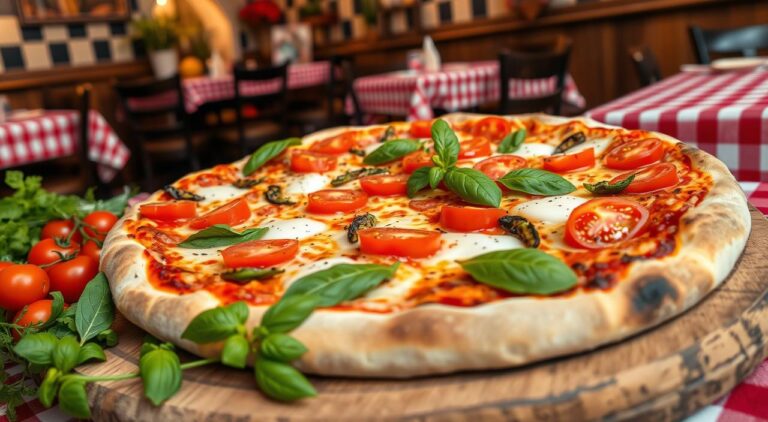Start a tasty journey through the world of Asian desserts. Here, old traditions meet new tastes to delight everyone. You’ll find everything from creamy mango sticky rice to light matcha sweets. These treats are a mix of flavors and cultures that everyone loves.
Let’s dive into the world of Asian desserts. We’ll explore the traditions and tastes that make them special. You’ll see how these treats bring joy to people all over the world.
Key Takeaways
- Discover the vibrant and diverse world of Asian desserts, spanning a wide range of flavors, textures, and cultural traditions.
- Explore the unique ingredients and techniques that define the artistry of Asian confectionery, from the fragrant essences of jasmine and pandan to the intricate sugar work.
- Gain an appreciation for the deep cultural significance and symbolic meanings behind many Asian dessert traditions, which are often intertwined with celebrations and special occasions.
- Uncover the regional specialties and local delicacies that showcase the incredible diversity of Asian dessert cultures, from East Asia to Southeast Asia.
- Learn how to recreate authentic Asian dessert recipes at home, with step-by-step guides and expert tips to bring the flavors of Asia to your kitchen.
Asian Desserts: A Tantalizing Journey for the Senses
Start a thrilling journey into the world of Asian desserts. These treats amaze with their bright colors, interesting textures, and strong flavors. These flavors come from centuries of cooking traditions.
Exploring the Rich Flavors and Textures
Asian desserts range from creamy sweets with coconut to sweets with the sweet smell of rosewater. They mix tropical fruits, spices, and ingredients like rice and mochi dough. This mix creates a mix of flavors that please the taste buds.
The textures vary from smooth puddings to chewy mochi. These textures make eating Asian desserts a unique experience.
Cultural Significance and Traditions
Asian desserts show the area’s rich culture. Many asian desserts and oriental sweet delicacies are part of religious events, big celebrations, and family traditions. This gives each dessert a special cultural meaning.
They also show the skill and respect in making asian sweets and traditional asian treats. You’ll see sugar art, flower petal designs, and special ingredients like red bean paste or lotus seeds.

“Savoring an oriental dessert is not just about satisfying one’s sweet tooth; it’s a journey through the flavors, textures, and traditions that have been passed down for generations.”
When you try asian desserts, you’ll see a world of culinary art, cultural importance, and tastes. This will make a big impact on your taste buds and how you see these oriental sweet delicacies.
Popular Asian Desserts to Tantalize Your Taste Buds
Across Asia, a world of delicious desserts awaits. From the creamy mango sticky rice to the sweet rose-infused treats, these asian desserts and asian sweets take you on a flavorful journey. They show off the region’s rich tastes and traditions.
The oriental dessert red bean mochi is a favorite. It’s a soft, chewy rice cake filled with sweet red bean paste. This east asian confection highlights the skill and care in asian confectionery.
The asian pastry pandan chiffon cake is another hit. It’s a light, airy cake with the scent of pandan leaf. This traditional asian treat is a key part of many asian dessert recipes.
| Dessert | Origin | Key Ingredients |
|---|---|---|
| Mango Sticky Rice | Thailand | Sticky rice, coconut milk, mango |
| Red Bean Mochi | Japan | Mochi dough, red bean paste |
| Pandan Chiffon Cake | Southeast Asia | Pandan leaves, eggs, flour |
These asian desserts and asian sweets are more than just treats. They carry deep cultural meaning, often tied to big events and celebrations. Diving into their history and making them is a great way to explore east asian confections and asian confectionery.
“Asian desserts are a delightful symphony of flavors, textures, and cultural traditions that transport the senses to a world of pure indulgence.”
Regional Specialties: A Delightful Tour of Asia
Asia is a vast and diverse continent, with dessert traditions that show its unique tastes. Let’s take a delightful tour through East and Southeast Asia. Here, we’ll see how local ingredients, cultural traditions, and techniques come together to make sweet treats.
East Asian Confections
In East Asia, desserts range from Japan’s delicate sweets to China’s intricate pastries and Korea’s rich, chewy treats. Enjoy the buttery mochi, the sweet hōjicha-flavored sweets, and the chewy Korean Ppopgi. These east asian confections highlight the region’s skill in texture, balance, and subtlety.
Southeast Asian Sweet Delicacies
Head south to find the vibrant and tropical tastes of Southeast Asian sweet delicacies. Try the creamy Thai Khao Niaow Ma Muang, the delicate Malaysian Ondeh-Ondeh, and the sweet coconut and palm sugar Indonesian Klepon. These asian sweets show off the region’s rich fruits, grains, and aromas.
| East Asian Confections | Southeast Asian Sweet Delicacies |
|---|---|
| Mochi (Japan) | Khao Niaow Ma Muang (Thailand) |
| Hōjicha-flavored Sweets (Japan) | Ondeh-Ondeh (Malaysia) |
| Ppopgi (Korea) | Klepon (Indonesia) |
On this asian desserts journey, get ready to be amazed by the diverse and tasty flavors of East and Southeast Asia.
Ingredients and Flavors That Define Asian Desserts
At the heart of Asian desserts is a mix of ingredients and flavors that make them special. They use coconut milk for its silky smoothness and pandan leaves for their earthy richness. This mix creates a unique taste and texture experience.
Traditional Asian treats often feature sticky rice. This rice makes desserts chewy and glutinous. It’s often paired with tropical fruits like mangoes, lychees, and jackfruit. Together, they make desserts that celebrate the region’s rich produce.
| Ingredient | Flavor Profile | Common Dessert Applications |
|---|---|---|
| Coconut Milk | Creamy, rich, slightly sweet | Coconut puddings, rice cakes, custards |
| Pandan Leaves | Fragrant, vanilla-like aroma | Pandan-infused cakes, sticky rice dishes, jellies |
| Mango | Sweet, tropical, tangy | Mango sticky rice, smoothies, sorbet |
| Jackfruit | Savory-sweet, tropical, starchy | Jackfruit-based cakes, puddings, ice cream |
Asian desserts also use spices like ginger, cardamom, and star anise. These spices add depth and complexity to the flavors. They create a mix of sweet, aromatic, and savory tastes that delight the senses.
“The beauty of Asian desserts lies in their ability to transport you to a different time and place, where the flavors and textures evoke a sense of cultural heritage and tradition.”
Asian Desserts: A Feast for the Eyes
Explore the world of Asian desserts and discover their visual beauty. These treats are not just tasty but also a feast for the eyes. They make dining special with their stunning looks and detailed plating.
Artistic Presentations and Plating
Creating Asian desserts is like art, blending traditional skills with modern creativity. The way asian desserts are arranged, the colors used, and the designs, all show care. They aim to make you wonder and appreciate the effort.
Asian pastry chefs are true artists. They pay close attention to every detail. Using asian sugar art like sugar work, flower petals, and edible gold, they turn simple asian sweets into amazing works of art.
| Presentation Technique | Visual Impact |
|---|---|
| Intricate Sugar Sculptures | Delicate and intricate sugar-based structures that add a touch of elegance and whimsy to the dessert. |
| Edible Flowers and Petals | Vibrant and colorful floral elements that enhance the natural beauty of the asian desserts. |
| Metallic Accents | Shimmering gold or silver touches that elevate the overall presentation and create a luxurious impression. |
The art in presenting oriental sweet delicacies does more than just please the taste buds. It also catches the eye, making the dining experience unforgettable for everyone who tries these desserts.
Traditional Asian Dessert Recipes to Try at Home
For those eager to explore the world of asian desserts, this section provides step-by-step guides and tips for recreating traditional recipes in your own kitchen. From the vibrant and creamy mango sticky rice to the delicate and chewy Japanese mochi, you’ll find detailed instructions and insights to help you master the art of crafting these captivating asian confectionery delights.
Mastering Mango Sticky Rice
Mango sticky rice is a beloved traditional asian treat that combines the sweetness of ripe mangoes with the rich, creamy texture of sticky rice. To recreate this Thai classic, you’ll need glutinous rice, coconut milk, sugar, and fresh mangoes. Follow our step-by-step guide to achieve the perfect balance of flavors and textures.
- Soak the glutinous rice in water for at least 4 hours, or overnight.
- Drain the rice and steam it until tender and translucent.
- In a saucepan, combine coconut milk, sugar, and a pinch of salt. Bring to a simmer, stirring until the sugar dissolves.
- Add the steamed rice to the coconut milk mixture and gently fold to combine.
- Serve the mango sticky rice warm, topped with fresh, sliced mangoes.
Delicate Japanese Mochi
Mochi, the soft and chewy asian pastries, are a beloved Japanese dessert. These bite-sized treats are made by pounding sticky rice into a smooth, pliable dough and then filling it with a range of sweet fillings. Follow our instructions to create these delightful confections at home.
- Soak and cook the sticky rice until tender.
- Pound the cooked rice in a mortar and pestle or food processor until it forms a smooth, elastic dough.
- Divide the mochi dough into small balls and flatten them into discs.
- Fill the mochi with your favorite sweet fillings, such as red bean paste, ice cream, or fruit.
- Dust the mochi with a light coating of cornstarch or potato starch to prevent sticking.
With the right ingredients and techniques, you can bring the flavors and textures of asian desserts to life in your own kitchen. Explore these step-by-step guides and let your culinary creativity shine as you master the art of crafting these delectable traditional asian treats.
Fusion and Modern Interpretations
In the world of Asian desserts, we’ve seen a big change. Traditional treats are now mixed with new ideas, blending East and West. This has given us exciting new tastes and looks.
Chefs and sweet makers love to try new things. They want to make Asian pastries even better. They use new ingredients and methods to create desserts that honor Asian sweets. At the same time, they add a modern touch.
Now, traditional Asian dessert recipes have a new twist. And there are new desserts that mix East and West flavors and looks. This change has made Oriental desserts more interesting and fun for everyone.
| Traditional Asian Desserts | Fusion and Modern Interpretations |
|---|---|
| Mochi | Mochi Waffles with Matcha Ice Cream |
| Pandan Cake | Pandan Chiffon Cake with Coconut Crumble |
| Taro Balls | Taro Bubble Tea Popsicles |
| Red Bean Buns | Red Bean Bun Croissants |
These new Asian confectionery treats are not just tasty. They also look great and are fun to eat. By mixing traditional Asian treats with new cooking ways and tastes, chefs are changing what we think of as an Asian dessert.
“The fusion of East and West in desserts opens up a world of endless possibilities for us to explore and delight in.”
The future of Asian dessert recipes looks exciting. As we keep mixing cultures and tastes, we’ll see more new and interesting desserts. This will help us appreciate the old traditions that inspire them even more.
Asian Dessert Culture: Celebrations and Occasions
Asian desserts are a big part of the continent’s culture. They are often the stars during celebrations, festivals, and special events. These sweets go beyond just being treats. They are seen as a way to share cultural heritage and tradition.
From Japan’s delicate mochi to the Philippines’ vibrant halo-halo, these desserts carry deep meanings. They are part of both everyday life and special events. This shows the rich diversity and unique customs of the region.
Celebrations and Traditions
- Chinese New Year is filled with lucky desserts like nian gao and tang yuan dumplings.
- In India, gulab jamun and jalebi are key during Diwali. They symbolize prosperity and happiness.
- The Vietnamese banh tet, a sticky rice cake, is a favorite during the Lunar New Year.
Asian desserts are more than just sweets. They are filled with cultural meaning. They reflect the values, beliefs, and dreams of those who make and enjoy them. Each dessert has its own story, inviting us to dive into the world of asian dessert culture.
“Asian desserts are not just sweet treats, but works of art that embody the spirit and traditions of the cultures that birthed them.”
Conclusion
As we end our journey into Asian desserts, we see how these treats are more than just sweets. They are a deep dive into flavors, textures, and traditions. From the detailed Asian confectionery to the bright Asian pastries, they delight our senses.
The variety of traditional Asian treats shows the creativity and skill of Asian cultures. Each has its own special mix of ingredients and ways of making them. Whether it’s the perfect mix of sweet and sour in Asian sweets, or their stunning looks, these oriental desserts draw us in.
Keep exploring the wide world of asian dessert recipes. Enjoy the tastes, respect the traditions, and let these asian desserts take you on a journey. They celebrate the diversity and creativity of Asia’s sweets.










